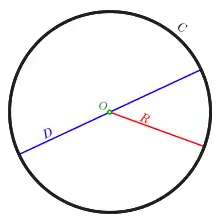Diameter
In geometry, a diameter of a circle is any straight line segment that passes through the center of the circle and whose endpoints lie on the circle. It can also be defined as the longest chord of the circle. Both definitions are also valid for the diameter of a sphere.

| Geometry |
|---|
 |
|
| Geometers |
In more modern usage, the length of a diameter is also called the diameter. In this sense one speaks of the diameter rather than a diameter (which refers to the line segment itself), because all diameters of a circle or sphere have the same length, this being twice the radius
For a convex shape in the plane, the diameter is defined to be the largest distance that can be formed between two opposite parallel lines tangent to its boundary, and the width is often defined to be the smallest such distance. Both quantities can be calculated efficiently using rotating calipers.[1] For a curve of constant width such as the Reuleaux triangle, the width and diameter are the same because all such pairs of parallel tangent lines have the same distance.
For an ellipse, the standard terminology is different. A diameter of an ellipse is any chord passing through the centre of the ellipse.[2] For example, conjugate diameters have the property that a tangent line to the ellipse at the endpoint of one diameter is parallel to the conjugate diameter. The longest diameter is called the major axis.
The word "diameter" is derived from Ancient Greek: διάμετρος (diametros), "diameter of a circle", from διά (dia), "across, through" and μέτρον (metron), "measure".[3] It is often abbreviated or
Generalizations
The definitions given above are only valid for circles, spheres and convex shapes. However, they are special cases of a more general definition that is valid for any kind of -dimensional (convex or non-convex) object, such as a hypercube or a set of scattered points. The diameter or metric diameter of a subset of a metric space is the least upper bound of the set of all distances between pairs of points in the subset. Explicitly, if is the subset and if is the metric, the diameter is
If the metric is viewed here as having codomain (the set of all real numbers), this implies that the diameter of the empty set (the case ) equals (negative infinity). Some authors prefer to treat the empty set as a special case, assigning it a diameter of [4] which corresponds to taking the codomain of to be the set of nonnegative reals.
For any solid object or set of scattered points in -dimensional Euclidean space, the diameter of the object or set is the same as the diameter of its convex hull. In medical parlance concerning a lesion or in geology concerning a rock, the diameter of an object is the least upper bound of the set of all distances between pairs of points in the object.
In differential geometry, the diameter is an important global Riemannian invariant.
In planar geometry, a diameter of a conic section is typically defined as any chord which passes through the conic's centre; such diameters are not necessarily of uniform length, except in the case of the circle, which has eccentricity
Symbol


The symbol or variable for diameter, ⌀, is sometimes used in technical drawings or specifications as a prefix or suffix for a number (e.g. "⌀ 55 mm"), indicating that it represents diameter. For example, photographic filter thread sizes are often denoted in this way.
In German, the diameter symbol (German Durchmesserzeichen) is also used as an average symbol (Durchschnittszeichen).
Similar symbols
The Latin small letter o with stroke ø is similar in size and design to this. The diameter symbol ⌀ is distinct from the empty set symbol ∅, from an (italic) uppercase phi Φ, and from the Nordic vowel Ø (Latin capital letter O with stroke).[5] See also slashed zero.
Encodings
The symbol has a Unicode code point at U+2300 ⌀ DIAMETER SIGN, in the Miscellaneous Technical set. On an Apple Macintosh, the diameter symbol can be entered via the character palette (this is opened by pressing ⌥ Opt⌘ CmdT in most applications), where it can be found in the Technical Symbols category. In Unix/Linux/ChromeOS systems, it is generated using Ctrl+⇧ Shift+U 2300space. It can be obtained in Unix-like operating systems using a Compose key by pressing, in sequence, Composedi.[6] In Windows, it can be entered in most programs with Alt code 8960.
The character will sometimes not display correctly, however, since many fonts do not include it. In many situations, the Nordic letter ø at Unicode U+00F8 ø LATIN SMALL LETTER O WITH STROKE (ø) is an acceptable substitute. It can be entered on a Macintosh by pressing ⌥ OptO (the letter o, not the number 0). In Unix/Linux/ChromeOS systems, it is generated using Ctrl+⇧ Shift+U F8space or Composeo/. AutoCAD uses U+2205 ∅ EMPTY SET available as a shortcut string %%c.
In Microsoft Word, the diameter symbol can be acquired by typing 2300 and then pressing Alt+X.
In LaTeX, the diameter symbol can be obtained with the command \diameter from the "wasysym" package.[7]
See also
- Angular diameter – How large a sphere or circle appears
- Caliper, micrometer, tools for measuring diameters
- Conjugate diameters – Perpendicular diameters of a circle or hyperbolic-orthogonal diameters of a hyperbola
- Diameter (group theory), a concept in group theory
- Eratosthenes, who calculated the diameter of the Earth around 240 BC.
- Graph or network diameter – Length of shortest path between two nodes of a graph
- Hydraulic diameter
- Inside diameter
- Jung's theorem, an inequality relating the diameter to the radius of the smallest enclosing ball
- Semidiameter – Term in geometry; half of a shape's diameter
- Sauter mean diameter
- Tangent lines to circles – Line which touches a circle at exactly one point
- The diameters of a screwthread
- Ø (disambiguation)
References
- Toussaint, Godfried T. (1983). "Solving geometric problems with the rotating calipers". Proc. MELECON '83, Athens. CiteSeerX 10.1.1.155.5671.
{{cite web}}: Missing or empty|url=(help) - Bogomolny, Alexander. "Conjugate Diameters in Ellipse". www.cut-the-knot.org.
- "diameter - Origin and meaning of diameter by Online Etymology Dictionary". www.etymonline.com.
- "Re: diameter of an empty set". at.yorku.ca.
- Korpela, Jukka K. (2006), Unicode Explained, O'Reilly Media, Inc., pp. 23–24, ISBN 978-0-596-10121-3.
- Monniaux, David. "UTF-8 (Unicode) compose sequence". Retrieved 2018-07-13.
- "wasysym – LaTeX support for the wasy fonts". Comprehensive TeX Archive Network. Retrieved 2022-03-11.